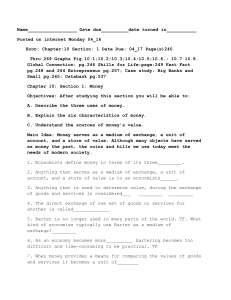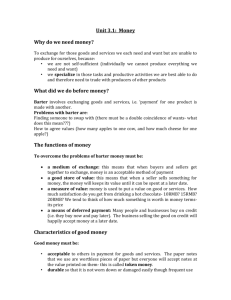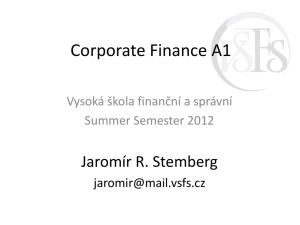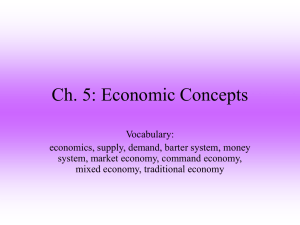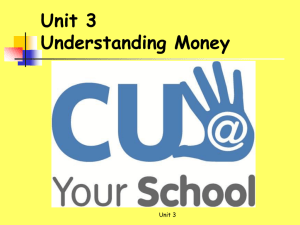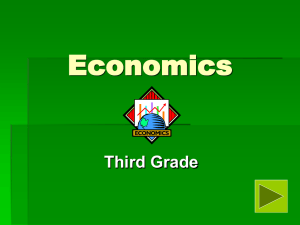EDCI 301: Lesson Plan
advertisement
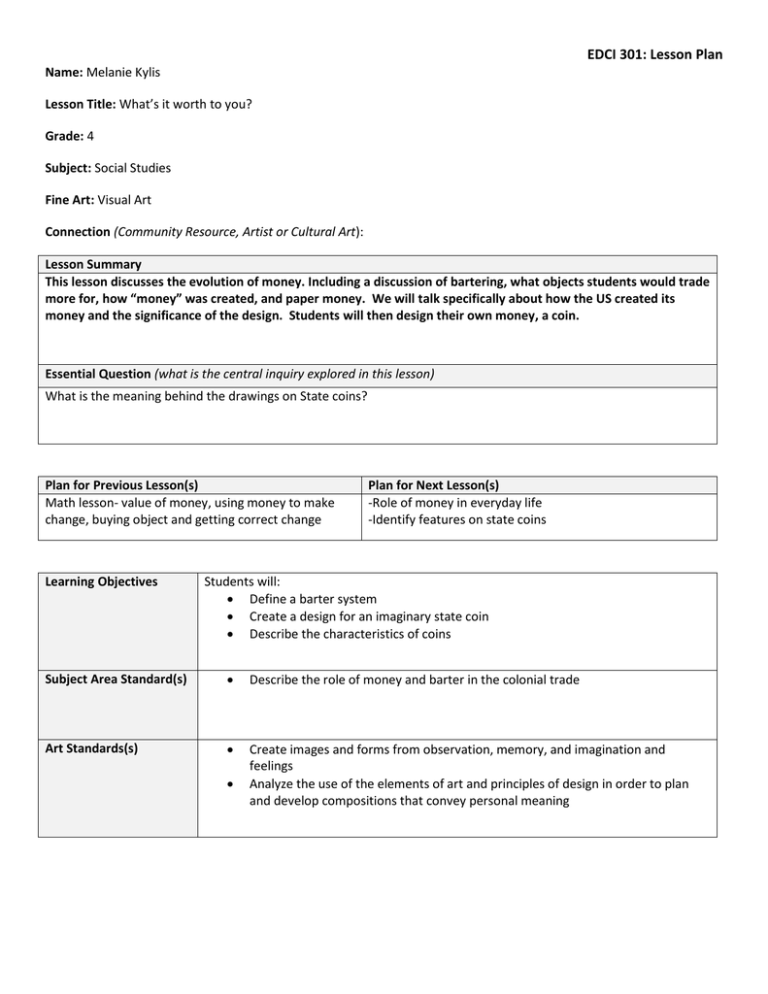
EDCI 301: Lesson Plan Name: Melanie Kylis Lesson Title: What’s it worth to you? Grade: 4 Subject: Social Studies Fine Art: Visual Art Connection (Community Resource, Artist or Cultural Art): Lesson Summary This lesson discusses the evolution of money. Including a discussion of bartering, what objects students would trade more for, how “money” was created, and paper money. We will talk specifically about how the US created its money and the significance of the design. Students will then design their own money, a coin. Essential Question (what is the central inquiry explored in this lesson) What is the meaning behind the drawings on State coins? Plan for Previous Lesson(s) Math lesson- value of money, using money to make change, buying object and getting correct change Learning Objectives Plan for Next Lesson(s) -Role of money in everyday life -Identify features on state coins Students will: Define a barter system Create a design for an imaginary state coin Describe the characteristics of coins Subject Area Standard(s) Describe the role of money and barter in the colonial trade Art Standards(s) Create images and forms from observation, memory, and imagination and feelings Analyze the use of the elements of art and principles of design in order to plan and develop compositions that convey personal meaning Materials/Resources (Instructional, Supplies, Technology) *Attach additional resources such as images, handouts, music etc. Video : http://www.youtube.com/watch?v=ZXIuFpu72Nk Vocabulary (terminology and definitions) Barter: to exchange goods without involving money (trade) Trade: action of buying and selling goods -examples of money -paper -markers, crayons, colored pencils Assessment: Rubric Evaluation Criteria I. Creative design/ features II. Definition of barter system/ exit card (Does not meet expectations) No effort (Approaches Expectations) Has state name and year None One sentence that briefly describes barter system A few sentences that explain barter systems Thoroughly defines barter system and gives example Symbol, but not a thorough explanation of its importance Symbol with writing explanation Symbol that is thought out and well explained in writing III. No symbol Has a picture/symbol to represent student Instructional Sequence -Set-up -Introduction -Core Activity -Closure Approximate Time 10:00 minutes 18:00 minutes 20:00 minutes 5:00 minutes (Meets Expectations) Has state name, year, and significant symbol (Exceeds Expectations) State name, year, significant symbol that has been carefully though out Procedure -get paper, coloring supplies, print examples of dollar bills and coins -value of objects, discuss bartering, example, video, what is money, have them interact and discuss what they would trade for something else -show examples of coins, give materials, allow students to design and draw -what is money? In small groups have students discuss how they decided on a design Instructional Sequence -Introduction: What’s It worth? -The beginning of money What is money Approximate Time 5:00 minutes -10:00 minutes Procedure -Begin talking about the value of objects. If you wanted to purchase a bag of chips at the grocery store, would you trade the cashier your shoes for the bag of chips? Of course you wouldn’t. Ask what they would trade for the chips instead Before money, people bartered. This means they traded objects to get the object they wanted/needed. -ask students if they barter and how? Share examples -Say you needed a cow, but you had a lot of corn. Your friend Johnny has cows so you went to ask him if you could trade 5 barrels of corn for his cow. Johnny already had enough corn, but he needed eggs so he would only give you his cow in exchange of 60 eggs. You did not have eggs so you had to go find someone else had a cow and would exchange it for your corn. It took a long time to find someone who would barter with you and the actual bartering process took a long time. People needed a faster way to get the goods that they needed. -Instead of swapping one item for another, there was an idea of using one thing to swap for everything else and this is how money began -Play video: http://www.youtube.com/watch?v=ZXIuFpu72Nk -Money is anything commonly accepted by a group of people for the exchange of goods and services. -Coins dating back to 5000 BC -Paper money since 1300 AD -Money in the United States 3:00 minutes -Discuss the money in the United States; show examples of bills and coins. -Ask students to describe the coin and possible significance of drawings -The Maryland State coin shows the Maryland Statehouse, which is important because it served as the nation’s first peacetime capital. Has the phrase “the old line state” -Core Activity: 50 States coins 20:00 minutes -Students will create their own coin Discuss how the coins represent something significant of the individual states heritage, geography, and history Students will then create their own coin design that represents something significant about them and a phrase that defines them -Closure 5:00 minutes -Why do we have money and why is it important? Why things are valuable, examples of what students think are valuable. Have students discuss in small groups how they came up with their design and what it means to them. Students will complete an exit card where they write about their design and then define a barter system and give an example. Plans to Display/Exhibit Student Work - “4th grade makes cents” - coins will be cut out, put on construction paper next to their exit card, and displayed on a bulletin board. *In-Class Art Lesson: Create a display/exhibit of the completed artwork, photograph the display, and attach/insert image *Analysis/Reflection: Complete only for In-Class Art Lesson Analysis: (Align questions in left column with answers in right column) What did the data from the assessment tools indicate about student learning? (include quantitative dataanalyze class rubric outcomes) I found that each student did very well based off of my rubric. I think this is because my rubric was very basic and I had it up on my PowerPoint while they were completing the lesson. I think this helped them get perfect scores because they were seeing exactly what they needed to have on their drawing to get a good grade. To what extent did the students explore the essential question and meet the lesson objectives? (include qualitative data – your observations and student feedback) My original essential question was: what gives money value? This question was not explored at all, but my new question: What is the meaning behind the drawings on State coins? Was explored more in the lesson. I think the students met the lesson objectives, they could define a barter system, they created their own quarter design, and they can talk about the characteristics of a coin. Reflection: (Align questions in left column with answers in right column) What worked in this lesson? Why? I think my video worked very well because it was fun and engaging. I also think my PowerPoint was good. Lastly, I think that my creative activity was a good way for students to explore state coins. What did not work well? Why? I needed to ask the students more questions and engage them more. I did not ask openended questions that allowed them to think more about coins and money, which is something I should have done. What adjusts did you make to the lesson while I did not really make many adjustments, I rushed through the PowerPoint because I thought I wouldn’t have enough time and I did not ask my long question about bartering teaching? Why? for a cow. What changes would you make to your lesson based on your experience of teaching it? I would definitely change my lesson by adding more questions. Questions are so important because they engage the student and they make them think. I would also have emphasized coins as a piece of art more. Lastly, I would have talked about the Maryland coin, who designed it, and how regular citizens submitted drawings for the design. I also would have had them talk about bartering systems in their exit card. How effective were your assessment tools? What modifications could you make to help students better demonstrate their learning? I do not think that my assessment rubric was that effective. I have made the changes on my rubric and I added a section about defining a barter system, something that I would have also added on my exit card. I think that my biggest modification would be to create a better assessment rubric and to ask more questions of the students. What insights about yourself and your teaching did this experience help you develop? I realized that I rush through my presentations and I need to slow down so that everyone can keep up. I also need to work on asking more questions of my students; allowing them to talk about their own experiences as well as making sure they are keeping up with what I am discussing. Lastly, I realized I need to work on creating rubrics and making sure they cover everything I want my students to learn.
